Want to develop an app’s MVP version?
It’s the right time. Well, if you are considering building an app first, then it can become your huge mistake. MVP app can help you to identify if your idea has a marketplace or not.
But, the question is, how to build an MVP app?
Well, you can build it simply with the right guidance.
Here’s the ultimate guide to build an MVP app in simple steps. Along with this, we will discuss the right metrics to measure its performance and if it passes or fails.
Let’s dive into the journey.
Understanding an App’s MVP
Before proceeding to how to develop an MVP? Let’s consider its concept first.
A minimum viable product is a version of software with enough features which be usable by early customers. It is the basic version that meets basic requirements for use, which can be adapted in the future.
In other words, it can be stated as a version to display sufficient features that can be used by early customers. Thereafter, this customer feedback is utilized for future product development.
Are you confused about which to build first, MVP or complete app?
Check out the next section.
MVP App vs Complete App: Which is the Best?
MVP app vs Complete App, which is the best to cover?
Well, the given comparison table can help you here.
| Aspect | MVP (Minimum Viable Product) | Complete App |
| Aim | Test the core functionality with minimal investment and gather user feedback. | Deliver a fully-featured, polished product to end-users. |
| Development Time Duration | Shorter development cycle, often a few weeks to a couple of months. | Longer development time, typically several months to over a year. |
| Development Cost | Lower initial cost due to fewer features and simpler design. | Higher cost due to comprehensive features, design, and quality assurance. |
| Risk | Lower risk, as adjustments can be made based on early feedback. | Higher risk, as a significant investment is made without user feedback. |
| User Feedback | Early feedback can be gathered to inform further development. | Feedback comes later after the complete app is launched. |
| Feature Set | Basic, essential features only. | Full feature set, covering all intended functionalities. |
| Market Fit Testing | Focused on testing the product-market fit early on. | Market fit is assumed and tested post-launch. |
| Scalability | May not be fully scalable or optimized for large-scale use. | Designed with scalability and future growth in mind. |
| Quality | Basic quality, potential bugs, and limited user interface design. | High quality, polished design, and user experience. |
| Time to Market | Faster, allows for quick entry into the market. | Slower, as more time is spent on development and testing. |
| Learning Opportunity | High, allows for learning from real user interaction and market response. | Limited opportunity to learn before launch; learning happens post-launch. |
| Investment Requirements | Lower initial investment with potential for incremental funding. | Higher upfront investment is required. |
| Flexibility | High, easy to pivot or make significant changes based on feedback. | Lower, changes are costlier and more time-consuming post-launch. |
| User Expectation | Users expect a work-in-progress with room for improvement. | Users expect a complete, polished product. |
| Monetization | May delay monetization until the product is more fully developed. | Ready for monetization from launch. |
Well, from the above table, you can decide on the reason to build an MVP app first.
However, you should go for a mobile app’s MVP that can assist in achieving your dream success.
Why Creating an MVP App is Crucial?
Before we proceed to how to create an MVP app for a startup, it is essential to learn why to develop it.
Here is the list of reasons to develop an MVP of the app.
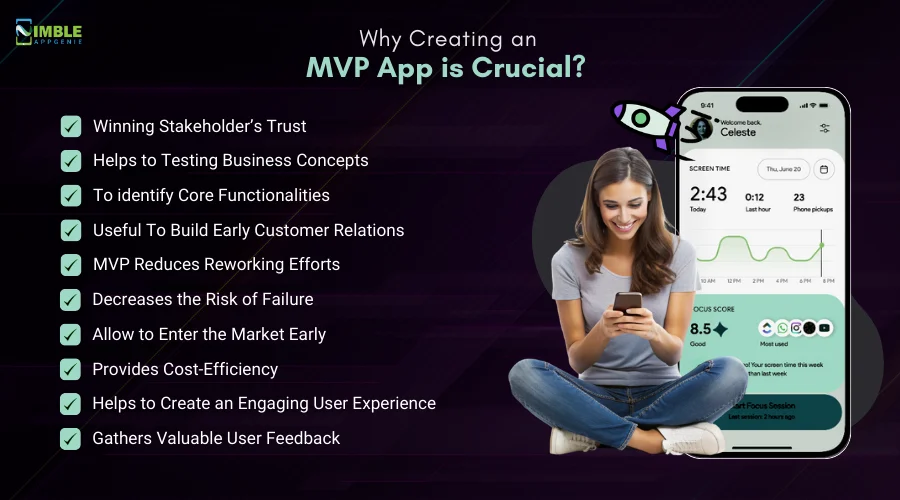
♦ Winning Stakeholder’s Trust
Creating an MVP app is an important way to develop the trust of the stakeholders and investors which helps in securing funding as well as starting a mobile project. The key to motivating the employees to buy it is to develop confidence in the product that you are pitching.
♦ Helps to Testing Business Concepts
Another important benefit to build an MVP app is it helps to resonate the product and service that you are offering with that of the target customers. After the launch of the product, you can identify how many users are interacting with your MVP.
♦ To identify Core Functionalities
Developing an MVP is important for identifying core functions of the app that will be useful in achieving the aim of the business. You can deliver more high-quality products after identifying the basic functions of your startup.
♦ Useful To Build Early Customer Relations
The app development process takes time, hence MVP launch can help in building long-term relations even before the launch of an app. It is essential to connect with the users and creating an app’s MVP version can shape a more friendly community.
♦ MVP Reduces Reworking Efforts
Effective research and design functions can help to reduce the risk of building unwanted features within an app. Additionally, building enough features can validate your hypotheses which means it will minimize the reworking procedure for your MVP app.
♦ Decreases the Risk of Failure
Every business wants to achieve the desired success, right? Well, developing an MVP helps to decrease the chances of failure by identifying future risks and addressing the errors in building the complete app. MVP helps to identify any user’s demands and to implement them for further engagement.
♦ Allow to Enter the Market Early
Developing an MVP of mobile app can help you enter the market early and start generating revenue quickly. Along with this, it takes less time to develop than an app which helps to avail it to the target audience as well as to meet the urgent demand of your audience.
♦ Provides Cost-Efficiency
Developing an app’s MVP saves time and cost by making decisions that rely on facts as well as feedback. It might seem costly at first, however, it resolves the issue concerned with rectifying users’ demand effectively which helps reduce costs in the long run.
♦ Helps to Create an Engaging User Experience
If you are eager to engage the target audience in the long run, then creating an MVP app is the prominent solution. While designing an MVP, you only need to keep the user center of your app development by ensuring that the product is intuitive, visually appealing as well as simple to navigate.
♦ Gathers Valuable User Feedback
MVP of mobile app development assists the users in gathering valuable feedback, through releasing a minimum product version. You should gather feedback for improving the quality of your app and implementing it effectively.
These are some of the reasons why you should go for developing an MVP effectively. Now, that you’re aware of the importance, let’s learn when to develop an app’s MVP version.
When to Create an MVP for App?
After considering “how to make an MVP?”
Now, the next question is “When to build an MVP?”
Well, let’s understand the right time to build an MVP app.
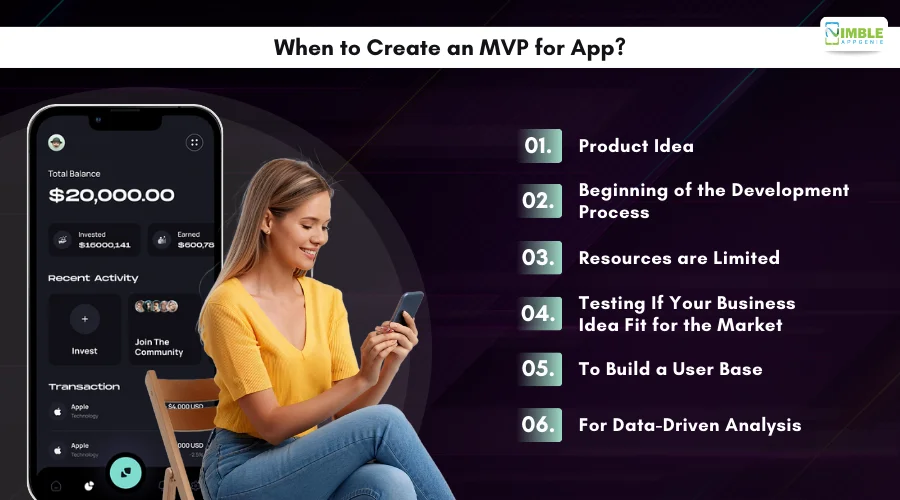
1. Product Idea
When you get a mobile app idea suitable to stand out from the market competition and which can solve users’ issues, then it’s the right time to develop an MVP.
If you want to gather user feedback for your product or service, through building an app, then designing an MVP will work.
2. Beginning of the Development Process
Once you decide to launch your idea in the market, then it’s the right time to go with MVP development.
It is important to consider MVP at the beginning of the product, to gather user feedback, which will be valuable for your product improvement.
3. Resources are Limited
When you have a limited budget for app development, then it’s viable to go for building an MVP first. It will help you to save overall resources.
After developing an MVP, you can track the performance of your app and decide to carry it with the features or mold it accordingly.
4. Testing If Your Business Idea Fit for the Market
Gauging the market demand is difficult, but through MVP app development, you can execute it effectively. Here you can evaluate simply, if your idea is for the market or not.
It will provide you will ideas for improvement and to analyze the current changes within user’s demands.
5. To Build a User Base
When you’re confused about attaining as much as the audience needed for your app’s survival, developing an MVP can become an effective option, here.
You should be able to connect with the user base efficiently when their changing demands can be evaluated.
6. For Data-Driven Analysis
When you require a data-driven analysis for guiding the further development process for your app, then developing an MVP is the best option.
It will be useful in creating value for your product, and to reach the target audience, efficiently through evaluating their current demands.
Now, are you ready to develop an MVP?
Well, then let’s consider some of their types in the next section.
Types of MVP Development
How many types of MVP development exist?
Here is the list of types of MVPs that you can consider.
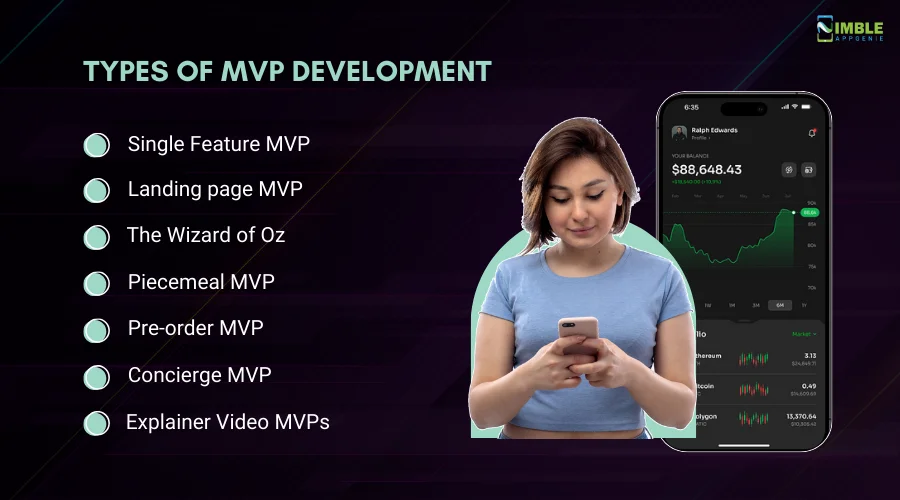
-
Single Feature MVP
The purpose of single feature MVP is to develop a product that stands out from the competition. It is essential to focus on one issue and this MVP exactly does this. It helps to provide solutions to a niche group, after considering a single issue.
-
Landing Page MVP
A landing page MVP offers different strategic advantages for startups and businesses to desire to create a powerful and simple web page with minimum investments. The main aim of this MVP is to collect information from contracts in exchange for value.
-
The Wizard of Oz
It involves creating a completely functional product while the manual process of its related features is still in progress. This MVP should be used for testing the market for the product without spending time over money time on developing it.
-
Piecemeal MVP
Piecemeal MVP is different from the other mentioned types. Here you utilize existing tools as well as services to deliver a functioning product to the customers. This type of MVP decreases the steps undertaken to build an MVP through prevailing third-party tools.
-
Pre-order MVP
Here, the startups and entrepreneurs use this approach for evaluating the users’ demand and earning revenue before investing in a full-scale development. You can develop a landing page as well as websites that generate interest as well as allow customers to pre-order the product and service.
-
Concierge MVP
Concierge MVP refers to the approach where MVP is developed and designed in a personalized manner. It includes manual and high-touched interactions to increase user experience. Here, the client’s demands are kept on priority to include their touch over MVP.
-
Explainer Video MVPs
An explainer video MVP comprises developing a video that explains the product as well as its features. It can be further shared with the target audience to gauge their interest and receive feedback.
These were some of the types of MVPs to be considered before you decide to develop them effectively.
Now, are you bothered about how many of the big brands have done it?
Well, there are plenty of them, check out the next section.
Famous Examples of Successful MVP Apps
Till now, we have discussed MVP concept, why develop it, and when you should go for one. Now, it’s time to know how famous brands have carried it.
Here’s a list of popular MVP examples. Let’s check them out one after the other.
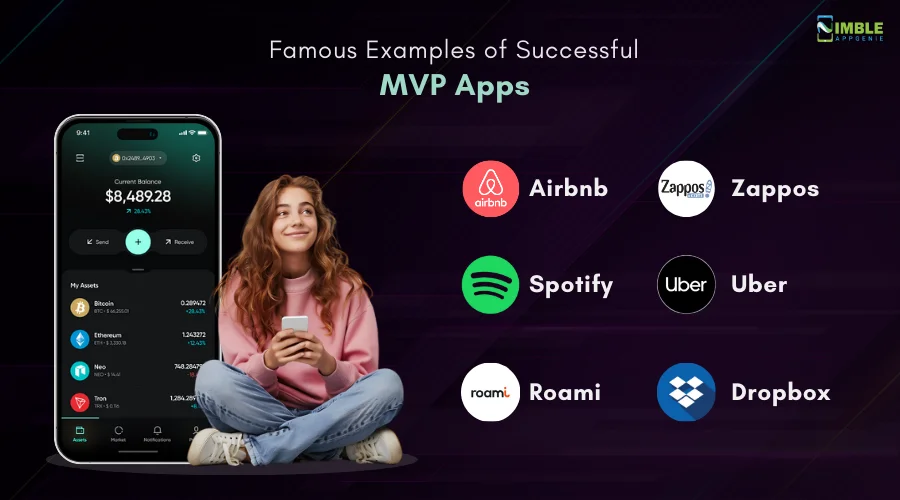
Example 1: Airbnb
It all started when Chesky and Gebbia faced an issue related to high-priced hotel rooms and needed an affordable place, where people would be willing to pay to stay with them.
Then they give their idea a try by developing a concierge MVP. They open up their apartment for short-term rental purposes for the attendees of a nearby conference to earn an extra income.
They created a website and uploaded photos and then they got that there were plenty of people who wanted to rent their homes and of people who need it for short-term stay. This was where it all started through an MVP.
Example 2: Zappos
Zappos can be considered a famous example of the Wizard of Oz type of MVP. In 1999, Nick SWinmurn tested an approach where people are ready to buy shoes online before actually trying them out.
He has looked out for the nearby shops, to capture pictures of shoes and placed them on the website named Shoesite.com.
Then when he experienced that the consumers liked this model a lot. He rebranded it as Zappos, which later became a huge success and was acquired by Amazon in 2009.
Example 3: Spotify
Do you use Spotify for downloading and listening to your favorite singer or band?
Well, it all started in the 2000s, when people used pirated sites for downloading music. Then, its co-founders Daniel Ek and Martin Lorentzon, came up with an idea that offer a music streaming service.
They have tested it on their family and friends before presenting it to their target audience. In the current era, the app is the demand of millions of people around the world.
Example 4: Uber
Uber was launched as a scrappy MVP, which was exclusively available on iPhones and SMS limited to San Francisco.
The founders’ vision for the app was simple, where they dreamed of connecting drivers with passengers who needed a ride. Here, they have tested their vision for evaluating market needs.
When they identified that there was a market of such people interested in ordering caps, later after collecting and implementing users’ feedback, they launched a complete app.
Example 5: Roami
Roami offers a selection of rooms whose major purpose is to inspire people by offering cool spaces, which are even meant to provide the most memorable spaces for travelers.
The app founders Jason Fabbri and Greg Curiciosaw have solved a genuine issue related to sharing, creating as well as experiencing the local stories.
Within 6 weeks they designed an MVP which later witnessed a growth by connecting users across locations.
Example 6: Dropbox
Another brand that has launched a great MVP is Dropbox. The founders want to experience their end users to have a feel of the app even before the actual development process takes place.
They started with a demo video of MVP, where they detailed how this process will work and best for their audience.
The experience of the idea has resulted in a powerful success for the app after collecting valuable feedback from its users.
These are some of the famous MVPs that can assist you in deciding on the development of MVP.
Are you ready to develop your next MVP?
Stepwise Process to Develop an MVP App
Now, as you know that many famous brands have started their journey by developing MVP, it’s better to learn about its stepwise process next.
Within the guide to creating an MVP, here are the steps to initiate the process.
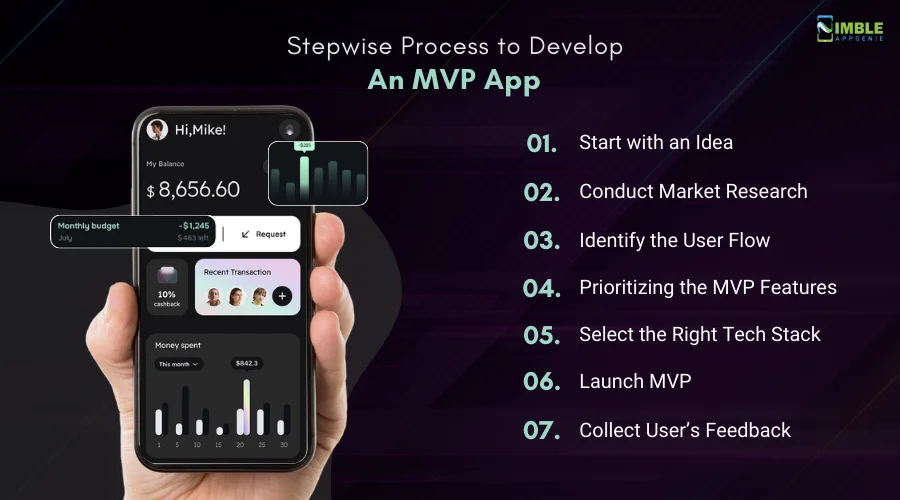
Step 1: Start with an Idea
When you recognize the issue of the customers, there all it starts. MVP cannot be initiated without an idea.
After exploring the problem of the target audience, you can explore it in detail to arrive at the exact solution.
On the other hand, if you are not satisfied with the existing solution, then exploring the one that can help is an idea to start MVP with.
Step 2: Conduct Market Research
You should conduct market research, for the identified problem to explore the current users’ demand.
Here, you should identify the target audience, calculate the market size, and perform MVP developments for startup demand research.
This will help you explore competitors and their demands. It is one of the important ways to connect with the audience’s preferences and learn about their changing perceptions.
Step 3: Identify the User Flow
Under this head, you should identify the user flow by evaluating the design procedure within this MVP stage. Here, you also need to finalize the UI/UX design along with defining the user’s journey within your app.
Within the user flow, it is essential to evaluate the process for looking at the app from a user’s perspective.
Identifying the user flow can help in determining the process stages for developing MVP. It is an important stage to ensure what the user actually desires and then sketch it out briefly.
Step 4: Prioritizing the MVP Features
Under this stage, you should evaluate and prioritize all the essential features that are supported by an app’s MVP.
Here, you have to categorize all the MVP features starting from high to low priority before launching it.
The result of this step can help you recognize the essential features for building a successful MVP.
Step 5: Select the Right Tech Stack
Now, in this stage, it’s time to select the right tech stack. Here, you need to decide on the technology that can help to develop an MVP.
You need to select the right technology to stand out from the competition, right? Well, that’s all needed here too.
Here, you can hire mobile app developers to select the right technology for your MVP development.
Step 6: Launch MVP
Well, now your wait is over to launch an MVP mobile app. Here, you can perform marketing to reach out to the targeted audience in one go.
You can decide the date to launch your MVP, it is the best way to plan and prepare strategy for the brand.
Under this step, it is important to work on every aspect that can impact the MVP. Along with this, it’s just an MVP, so you need not think much to launch as your complete product is still on the way.
Step 7: Collect User’s Feedback
User Feedback plays an important role here. It is the prime key to improving your MVP and complete product.
It is one of the important steps under which you can connect with the customers and then understand their demands to implement them effectively.
This step is one of the essential processes to improve the MVP by laying a strong foundation for your brand.
Furthermore, improving the MVP is one of the precious steps in its process of development.
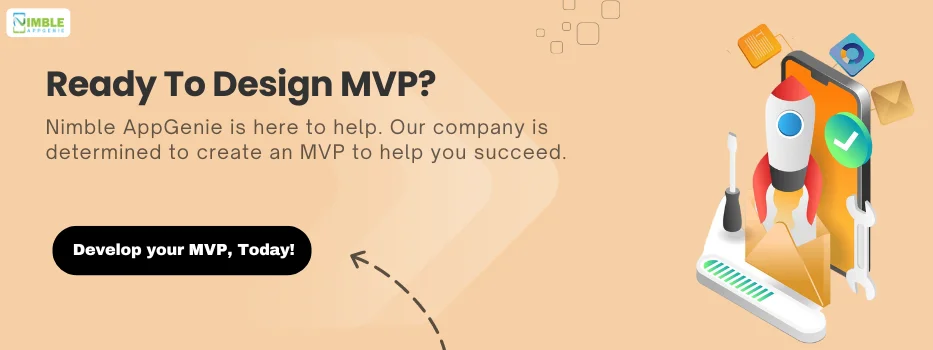 Mistakes to Avoid while Building an MVP for Mobile App
Mistakes to Avoid while Building an MVP for Mobile App
After learning about the stepwise process of building an app’s MVP, it is essential to avoid mistakes.
Are you bothered about how to avoid mistakes while building an MVP?
Let’s consider the following steps as the next important element in the guide to build an MVP.
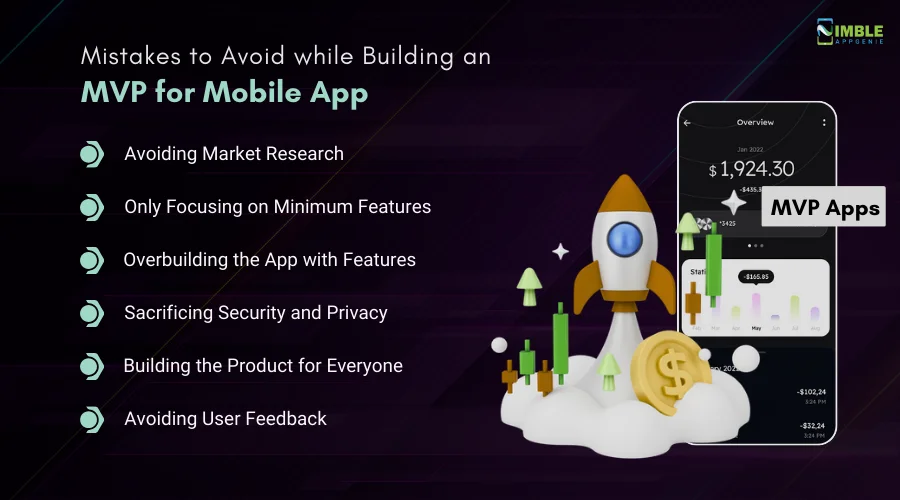
► Avoiding Market Research
Market analysis is all about finding if your MVP development can address the issue of your target users or not. If you avoid it, you will lose half of the way.
It is all about evaluating the competitors’ brand and identifying the changing demand of the users or alternatives they are using to resolve the issue. Avoiding it can result in losing your MVP.
► Only Focusing on Minimum Features
It is important to focus on minimum features while developing an MVP. However, one of the important things is making your MVP viable.
This is the foremost mistake that most of the brands making an MVP make. Hence, you need to avoid such an error by trying to make your MVP viable.
► Overbuilding the App with Features
Feature creep is among the most common mistakes that the majority of developers make. If you want your target audience to know you, help them find a clutter-free way to reach the solution.
Overloading the app with too many features is not among them. It is a dangerous trap for many entrepreneurs.
► Sacrificing Security and Privacy
While developing an MVP, you need to consider privacy and security as essential components, as ignoring them can kill your product.
Developers often make this mistake for quickly entering the market. They often forget the things related to privacy and mobile app security in the race to the market.
► Building the Product for Everyone
During the MVP app development procedure, if you ignore the target audience, you will lose the game. Here you will risk the product to be relevant for each person.
Additionally, if the product is not delivering enough value to solve the target audience’s issue, the result can be a failure.
► Avoiding User Feedback
After the development of MVP, user feedback plays an essential role. And if you avoid it, this can result in low adaption rates for the audience later.
Excluding the potential early users’ feedback, may not solve the problem for your target audience. You will lose them if you do not associate their critical comments.
These were some of the mistakes that you need to avoid while developing an MVP. Now, it’s time to learn about the cost of building an MVP.
What’s the Cost to Develop an MVP App?
Bothered by how much it costs to build an MVP app?
Well, within a comprehensive guide to develop an app’s MVP, here’s the estimated figure.
The average cost to build an MVP app can range from $10,000 to $150,000.
Multiple factors can impact the complete costs such as complexity, number of features, design, tech stack compatibility, and others.
Additionally, the selection of the development team can affect the complete cost of building an MVP.
Furthermore, there are certain top practices that you should consider while developing an MVP. Let’s learn them all in the next area.
Top Practices to Consider While Making an MVP
Do you want to stand out from the competition?
Well, then consider the list of top practices here for building an MVP.
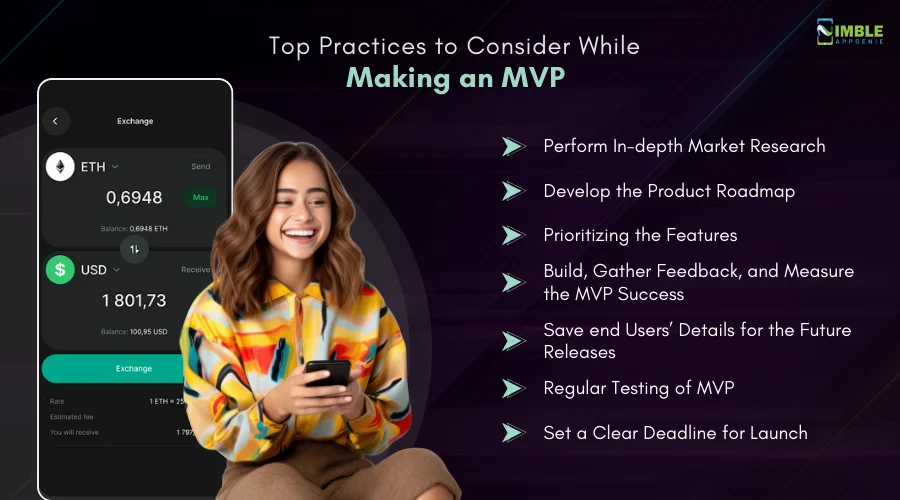
1] Perform In-depth Market Research
Yes, it is essential to launch the MVP as soon as possible to capture the right audience. However, launching it without performing market research can impact the complete performance of the app.
2] Develop the Product Roadmap
A product roadmap plays an essential role and is important to guide the strategic direction of mobile app development. You can start with a high-level strategic vision to come up with a plan that can help to address the concerns of target users.
3] Prioritizing the Features
Identifying the most suitable features for your app is the foremost step to consider while making an MVP. It is an essential activity in MVP app development, where you finalize the features to be launched in the first go.
4] Build, Gather Feedback, and Measure the MVP Success
A regular check over the app’s MVP success is essential for reaching the right audience at the right time. It will assist you in knowing and learning about the users and molding the MVP accordingly. Here you should gather useful user feedback and align it with their current needs.
5] Save end Users’ Details for the Future Releases
Under this practice, you should save user details for fetching the data points that can be implemented in the future. Further, having an analysis of how users interact with the brand will help you to drive a report related to delivering them valuable results.
6] Regular Testing of MVP
In the process to build an MVP app from scratch, it is essential to perform regular testing to enhance the complete design process. Along with this, you should consider bug testing, which will help to resolve app errors in the long run.
7] Set a Clear Deadline for Launch
Conducting only market research and getting the MVP launch delay is not an effective option. The consequence can be, that it will provide a market for your competitor to grasp the audience first. Hence, you should set a clear deadline for launching the MVP for your business success.
Considering the above practices for developing an app’s MVP, you should give it a fresh start.
Now, the question is how should you measure if your MVP has a desired marketplace?
How to Measure MVP App’s Success?
Till now, you learned about the MVP concept, its needs, types, examples, mistakes, and steps to build it. To evaluate whether your app’s MVP can capture the right interest of users or to identify whether there is a place for your idea in the market, it is essential to measure its performance.
You should consider the process of measuring as well as analyzing it even before you plan to release it for the early adopters.
But how to measure the success of your MVP?
Let’s consider the given process here.
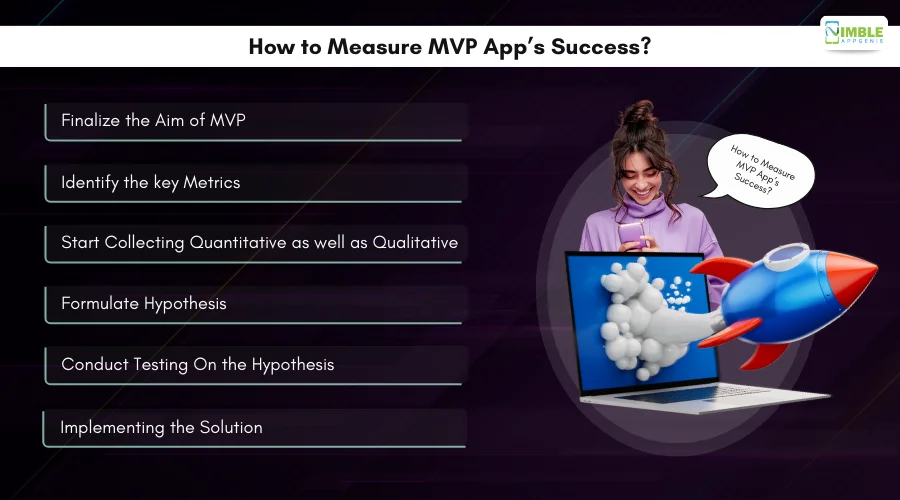
♦ Finalize the Aim of MVP
During the process of creating an MVP app, you must have framed the aim, right? Now, within the measuring procedure, it is essential to match it with the standard performance. Comparing your actual performance with that of the targeted one can help to identify the gap.
♦ Identify the key Metrics
You need to evaluate the key metrics before you begin the process of analyzing and evaluating the success of an MVP of mobile app. This is the defined area where you can select the type of metrics as per your preference and MVP requirements.
♦ Start Collecting the Quantitative as well as Qualitative
Now, you should collect the data from the early adopters to analyze and evaluate MVP’s performance. You can have both kinds of data that might include quantitative as well as qualitative data. The process of collecting it can be considering interviews or surveys among early adopters.
♦ Formulate Hypothesis
Then either you can hire researchers who can conduct a detailed study with the collected data to form a hypothesis or generate them by yourself. This will help you to reach over two important areas, then further you can select one of them as per analysis.
♦ Conduct Testing On the Hypothesis
Furthermore, in the next step, you need to perform testing on the hypothesis. It is an essential part of arriving at a decision related to MVP success and its current performance. Here, you should continue monitoring the data to identify the reason for the gap.
♦ Implementing the Solution
Now, as you get the results and reason for why the standard performance of your app’s MVP has not been achieved yet. Here, you should be able to implement the solution for achieving the determined aim for your MVP.
These were the stepwise guide to measure the overall performance of the mobile app’s MVP.
If you want to identify the key metrics for gauging the success of your MVP, then the next section describes it all.
Right Metrics to Gauge MVP Success
The right metrics can help you to improve the complete process to gauge the success of MVP.
Now, the question is, what are the right metrics to measure its complete success? Let’s learn them all here.
There are certainly two types of metrics available to measure MVP success.
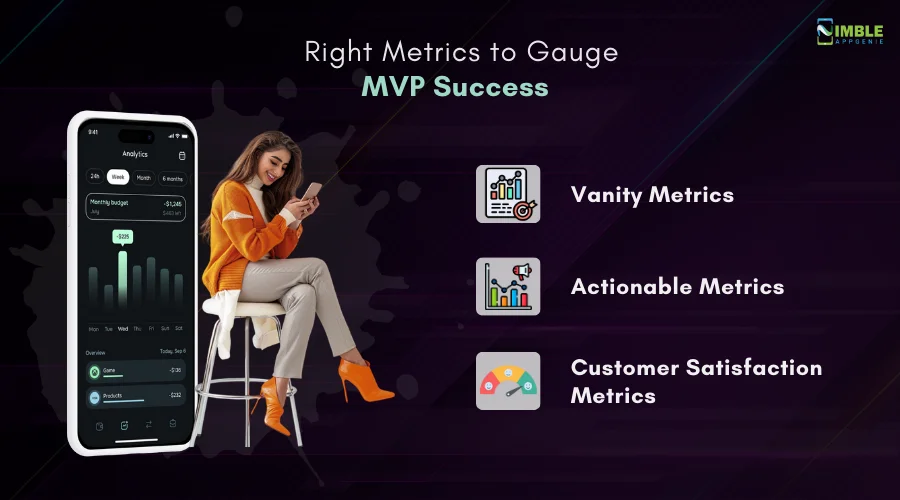
-
Vanity Metrics
This type of metric concentrates on measuring the performance through the outside content that comprises of number of subscribers, MVP downloads or website clicks, page views, and total revenue earned from its launch time till now.
-
Actionable Metrics
It is a kind of app’s MVP metric that helps to gauge its performance by identifying the users’ churn rate, cost of acquisition, lifetime value, and time spent over the platform. This is an important metric for measuring the relation index of your customers.
-
Customer Satisfaction Metrics
This type of metric can help you to identify net promoter score (NPS), user satisfaction, feedback, and all other essentials related to customers. It will help you to identify what, your customer’s preferences are and how they can help arrive at the actual output.
After measuring its performance, you will get a clear picture of the current position of your MVP apps in the market.
Now, after measuring the complete performance of your MVP, you might come across two situations here.
One- It’s a success
OR
Second- it’s a failure
Let’s understand what you can do in both situations as a consequence of your evaluation process in the next section.
What to do if Your App’s MVP is a Success?
Let’s consider the first situation first.
What if your MVP of mobile app achieves the desired target you set as the aim of the business?
Well, congratulations you did it!
Here are the steps to follow for an MVP success.
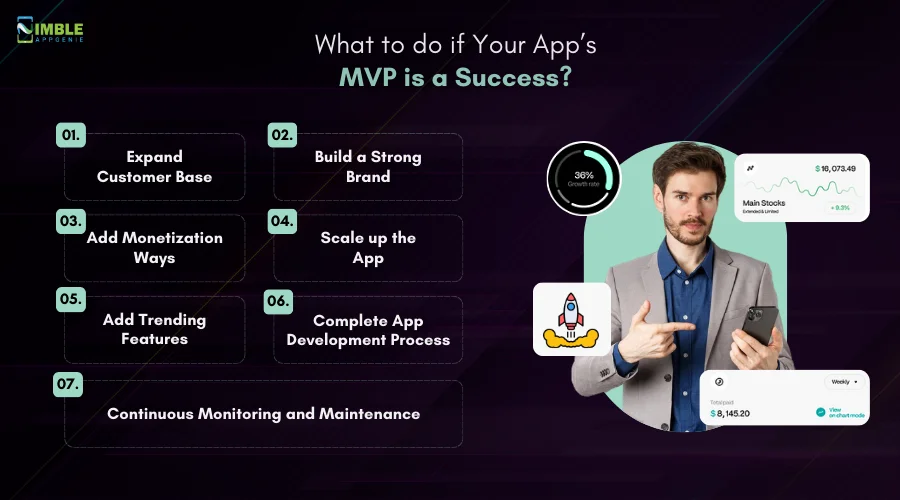
A] Expand Customer Base
One of the important steps, to pursue after your app’s MVP results in success, is to expand the customer base.
You should implement certain growth strategies for developing effective marketing as well as sales strategies for acquiring new customers.
Here, adopting social media strategies and partnering with the right brands can help.
B] Build a Strong Brand
Now, you need to improve your brand’s existence in the market because now, you evaluated that there is a market for your idea and product.
You can invite investors and can even go for multiple market-entry modes to capture the interest of the target audience.
Creating a good brand image is important in this step. You can opt for mobile app marketing models to increase your app’s market presence.
C] Add Monetization Ways
Well, it’s time to add app monetization models to open revenue streams. This will assist you in defining the ways you can earn money through the MVP app.
Under this step, you should have an awareness of effective monetization models that will fit into your brand’s success.
You can test different pricing strategies to maximize the profitability of your brand.
D] Scale up the App
Scalability plays a vital role in a brand’s expansion. Your app should be able to handle growing traffic.
Hence, it is essential to handle the infrastructure of your app and improve it continuously to increase the performance of your MVP app.
Under this step, you can streamline the operations, which will support the overall growth of your mobile app’s MVP.
E] Add Trending Features
For boosting the overall infrastructure of your app, it is essential to add trending features that can grasp the attention of your end user and can increase your user base.
Here, you should note that adding up new features doesn’t mean compromising the core functionalities of the mobile app’s MVP.
Additionally, it need not appear as overcrowding the app with too many features.
F] Complete App Development Process
Under this procedure, you should be able to complete the procedure of app development. Here, you can ask your developer team to complete the process.
It is a procedure under which you can decide on the design process and should complete the remaining areas of your app.
If you have developed a web page or website as an MVP, then it’s time to add multiple features suited to achieve the aim of your app.
G] Continuous Monitoring and Maintenance
It is the last and continuous procedure. App maintenance support and services should be the ones to be considered, here.
Here, it is essential to monitor and analyze the complete app on a continuous scale. This is one of the important procedures where the health of an app is being explored.
App maintenance is important to sustain within the competitive market paradigm.
Well, now that you are aware of the first situation in which your MVP should fall, let’s consider the second situation, just in case it doesn’t succeed.
What to do if your Mobile App’s MVP Faces a Failure?
It’s okay to have an MVP failure because now, you know what kind of marketplace doesn’t exist.
But, why do MVPs fail?
And, what you should do if your app’s MVP has failed?
Let’s consider the given revamping MVP in detail.
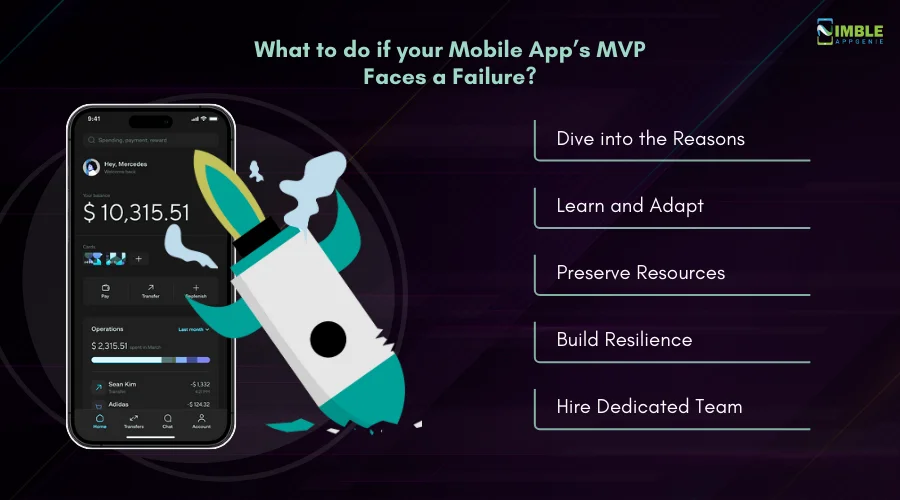
-
Dive into the Reasons
You should find out the reasons behind the failure and not give it up.
Here you can connect with real users and know about their perceptions of using the MVP model for the first time.
You should evaluate the purpose or need to work on capturing the right market. Here, it is evident to learn from your failure. You can hire a team for the same work.
-
Learn and Adapt
Another important step is to accept the failure, adapt the reasons for it, and learn a lesson.
This will help you to initiate the process or to make certain minor changes within the MVP that can make it a success.
Failure is not an issue, but ignoring the reasons why it fails or giving it all up can become a reason to completely abandon your dream later.
-
Preserve Resources
One of the major benefits you will get for developing an MVP is, it doesn’t screw you up.
You do not invest too many resources in its development which is the major reason that you have it for emergency funds.
This is an important step where you can make use of all these resources for your next idea.
-
Build Resilience
You should learn from the failures, and embrace setbacks as an opportunity for growth.
It is essential to maintain resilience for growth. Here, you can seek support and believe in your ability to overcome the challenges.
You can align with the start-ups’ methodology and goals, as these are the only measures that can help you to achieve success.
-
Hire Dedicated Team
As we already discussed, a dedicated team plays a vital role here. Hence, you should be able to hire a dedicated team that can help you improve the process.
You can prioritize steps that are based on the feedback. Additionally, lacking a proper development strategy,
Along with this, implementing too many features can be one of the important measures that can help you achieve success.
These are some of the steps that can assist you in improving the MVP of your mobile app.
Within the MVP app development guide, you have learned about the best ways to create it, right?
Well, if you are looking for a reputable and experienced firm, then it is essential to go for the next section.
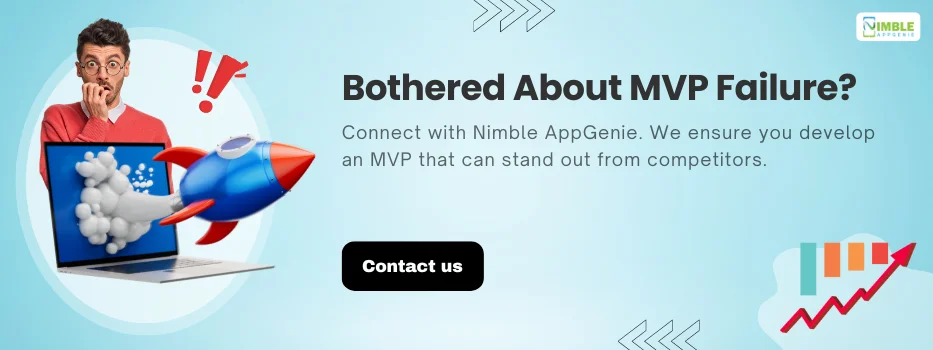 How Nimble AppGenie Help to Build an MVP App?
How Nimble AppGenie Help to Build an MVP App?
If you are looking forward to a company, then this section is for you.
Nimble AppGenie is the best MVP App Development Company that can help you with this process.
Our team is dedicated to providing you with service and to helping in your dream success. We ensure you have a valuable MVP that will cope with the defined measures and functions.
Well, are you ready to develop your app’s MVP version?
Conclusion
Minimal Viable Product is a software version, which contains enough features for early adopters. It is essential to make an MVP before you go for an app to improve your chances of success.
Other than this, developing an MVP can assist you in identifying core functionalities, testing the business concepts, helping in early market entry, and others. Furthermore, go for creating an MVP, when you have a product idea, limited resources, can test your business idea, and want to build a user base.
Additionally, there are multiple types you can opt for such as Wizard of Oz, single feature, lending page, pre-order, and others. With the right process, you can start building an MVP by having an idea, performing market research, and at last launching it in the market. Here, the cost depends on multiple practices success.
Furthermore, measuring them is an important concern to be considered. If it’s a success, you should proceed with developing an app, if it’s a failure, learn valuable lessons from it.
FAQs
The key differences between an MVP and a complete app are as follows:
- Aim: MVPs test core functionality and gather user feedback with minimal investment, while complete apps deliver a fully-featured, polished product.
- Development Time: MVPs have a shorter development cycle (a few weeks to months), whereas complete apps typically require several months to over a year.
- Cost: MVPs have a lower initial cost due to fewer features, while complete apps have a higher cost due to comprehensive features and design.
- Risk: MVPs involve lower risk as they allow for early feedback and adjustments, whereas complete apps carry higher risk due to significant upfront investment without user feedback.
Businesses should consider developing an MVP first for several reasons:
- Stakeholder Trust: An MVP helps gain stakeholder and investor trust by showcasing the product’s potential, which can secure funding.
- Testing Business Concepts: MVPs allow businesses to test their ideas with target customers and gather valuable feedback.
- Core Functionality Identification: An MVP helps identify essential features that are critical to achieving business goals, leading to higher-quality products.
- Early Market Entry: MVPs allow businesses to enter the market quickly, start generating revenue, and build customer relationships before a complete app is ready.
- Cost-Efficiency: By focusing on essential features, MVPs save time and resources, reducing overall development costs in the long run.
Common mistakes to avoid when developing an MVP include:
- Avoiding Market Research: Skipping market research can lead to developing a product that doesn’t address the target users’ needs, failing.
- Focusing Only on Minimum Features: While an MVP should have minimal features, it must still be viable and provide value to users.
- Overbuilding with Features: Adding too many features can lead to a cluttered product that confuses users, detracting from the MVP’s purpose.
- Ignoring Security and Privacy: Neglecting security and privacy in a rush to market can harm the product’s reputation and lead to serious issues later.
- Avoiding User Feedback: Failing to gather and implement early user feedback can result in a product that doesn’t meet users’ needs, reducing adoption rates.

Niketan Sharma is the CTO of Nimble AppGenie, a prominent website and mobile app development company in the USA that is delivering excellence with a commitment to boosting business growth & maximizing customer satisfaction. He is a highly motivated individual who helps SMEs and startups grow in this dynamic market with the latest technology and innovation.
Table of Contents




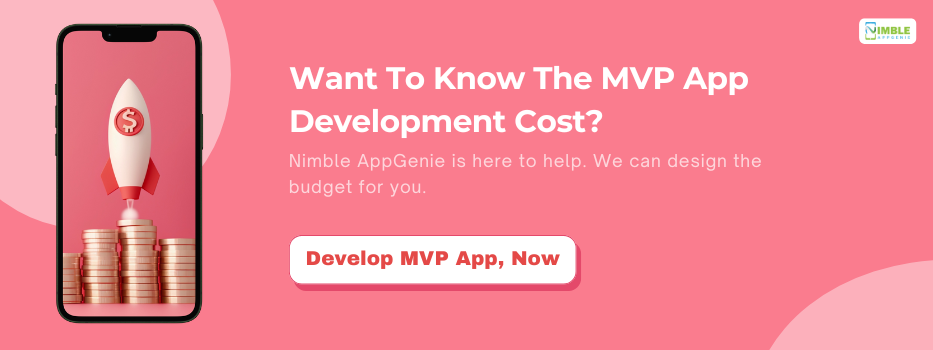
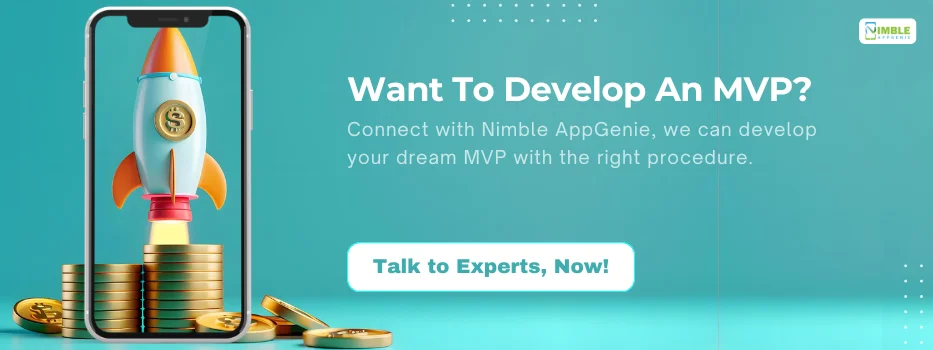
No Comments
Comments are closed.